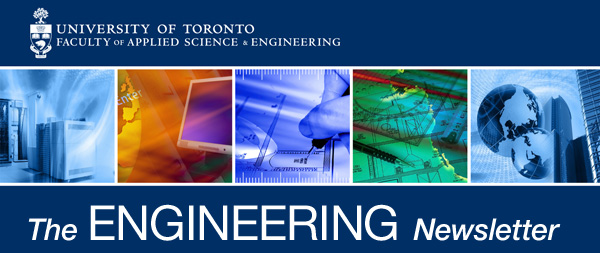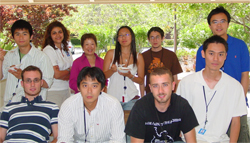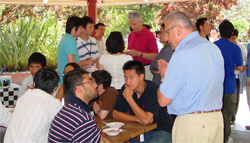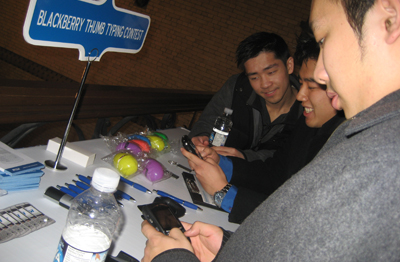 |
|---|
Q & A for the PEY Internship Program & Engineering Career Centre
In 2006, the Engineering Professional Experience Year Internship Program (PEY) and the Engineering Career Centre (ECC) merged to form one student-centred programming office geared to developing students to build the necessary skills for successful careers.
This year marks the 30th anniversary of Canada’s largest and oldest internship program, our PEY. The number of participating students is the highest of all time, and the office is set to move into an innovative new space on McCaul to better meet the growing needs of this demanding service.
 |
Engineering PEY students enjoying an ice-cream social during their internship at ACTEL Corporation (above and below). Based in California, ACTEL Corporation has been a long-standing supporter of the PEY Internship Program for the past 6 years recruiting Engineering students for both PEY and new graduate opportunities. |
 |
The Engineering Newsletter met with Chioma Ekpo, Program Coordinator for PEY and Nisha Panchal, Assistant Director of ECC to learn more about our PEY and career services.
![]() When the PEY office opened in 1979, what was the mandate?
When the PEY office opened in 1979, what was the mandate?
Chioma Ekpo: When the PEY Program was created in 1979, its mandate was to provide students with industry opportunities that would expose them to various fields in their specific engineering discipline. These opportunities would occur during their undergraduate studies prior to graduation.
Essentially, the program historically operated primarily as a placement agency. As an administrative program, PEY facilitated the recruitment needs of industry partners/employers seeking undergraduate students for 12-16 month paraprofessional internships. Employers submitted job postings and the program facilitated the recruitment process – posting opportunities for students to view, accepting applications, organizing on-campus employer information sessions and interviews, and eventually presenting job offers to students. From the student’s perspective, the motivating end result was achieving an internship placement.
![]() What is the mandate of the PEY office now?
What is the mandate of the PEY office now?
Chioma Ekpo: In 2004, under new leadership and direction, the program underwent a significant philosophical shift from a placement agency approach to an intensive student focused career development program.
This shift required not only a significant change in administrative practices, but also a radical change in the underlying philosophy guiding the program. Central to this shift was the idea that students are not mere numbers plugged into a placement calculus, but active agents with social, cultural, and emotional dimensions that require addressing.
Focusing on career development, rather than employment placement, we shifted from merely fulfilling the employment goals of a given company and the placement desires of students to emphasizing the development of students as agents.
Thus, the question that we addressed from students was radically reframed from “Will you find me a job?” to “Where am I now? Where am I heading? How do I get there?” As a development program, our focus shifted from churning out placements, to facilitating a process of engagement between the student and employer.
Through a process of redefinition and interpretation, the program thus offers students not only the opportunity to gain an internship placement but also to gain the skills to manage the internship and future employment opportunities.
Students are provided with the tools for ongoing self-assessment of their evolving career paths with the internship as the first stage along that path. This is achieved via an intensive program of small to large size workshop development sessions and individual counseling and consultation sessions, framed by three key elements of our approach:
- Viewing the Student as an engaged agent
- Reframing the Employment Relationship (the definition of an employee is redefined from passive to active, employee to professional)
- Reframing the idea or parameters of “Success”
![]() What is the mandate of the ECC office now?
What is the mandate of the ECC office now?
 |
Engineering students participating in RIM's Blackberry Thumb Typing competition during a RIM event at U of T in January 2008. |
Nisha Panchal: The Engineering Career Centre as
it is today is responsible for providing career development assistance and employment opportunities to students and alumni of the undergraduate Engineering population at the
U of T.
The Engineering Career Centre also houses such programs
as the Engineering Summer Internship Program (ESIP),
the Infrastructure Opportunities Program (IOP) and New Graduate hiring opportunities.
It also houses the Professional Experience Year Internship program, the largest internship program of its kind in the country.
ECC exists to provide a range of employment, career and self-development services for all engineering students at the U of T. It is continually developing to create and modify programs that enhance the potential of students and their value in the evolving marketplace and society at large.
![]() There has been a significant increase in students participating in PEY from 2003 – 2008. In the 2003-2004 PEY year, 257 Engineering students were out on PEY at 95 companies. In the 2008-2009 PEY year, 540 Engineering students are out on PEY at 172 companies. Why do you think more students are participating in PEY?
There has been a significant increase in students participating in PEY from 2003 – 2008. In the 2003-2004 PEY year, 257 Engineering students were out on PEY at 95 companies. In the 2008-2009 PEY year, 540 Engineering students are out on PEY at 172 companies. Why do you think more students are participating in PEY?
Chioma Ekpo: Increasingly, educators and industry representatives are recognizing the importance of preparing students for the workplace, experientially as well as academically, prior to graduation. This is evident in the growth of internship and coop programs across the country where students have an opportunity to apply their academic knowledge outside of the classroom.
PEY meets this need by providing students with 12-16 month paid internships through paraprofessional opportunities crucial to the development of a professional engineer. In its unique delivery of an intensive student focused career development program, PEY is preparing students not only for career opportunities, but the overall dynamics of the workplace.
From the student perspective, the PEY Program’s integrative approach presents them with a new way of viewing the world of work and their role in it. Students attain an understanding of the difference between an employee (operating within a fixed mandate as directed) and professional (operating in relation to a larger organizational mandate with a focus and clear vision), thereby enhancing their ability to develop key career management competencies.
By participating in a series of group workshops, seminars, and one-on-one consultations, students work towards developing a clear vision of where they are, where they are heading, and how to navigate their career path. More importantly, by aligning their passion and career objectives, and elevating their tolerance for risk, students are provided with opportunities to realize their potential and take on challenges that allow them to exceed expectations – both of themselves and of their employers.
![]() How is PEY different from the University of Waterloo Coop program?
How is PEY different from the University of Waterloo Coop program?
Chioma Ekpo: The PEY paid internship is 12-16 months in length and the Waterloo Coop is 4 months in length over three work terms. The internship length allows students to gain experience over a long period, wherein they are involved in a project from conception to completion to application, as well as developing some understanding of the interpersonal and political dynamics that occur in the workplace. As such, this key difference in the duration frames the expectation of the employers in terms of their return on investment and thus equally frames how we prepare our students to meet and exceed those expectations.
![]() What is the typical process for a student interested in applying for PEY?
What is the typical process for a student interested in applying for PEY?
Chioma Ekpo: Prior to the program’s application deadline, we hold PEY information sessions at the beginning of the school year in September, and again in March to accommodate new interest from students. The sessions allow us to provide a clear objective for participating in the program – not to find students jobs, but to provide them with the critical tools necessary to self-assess and align their interests and career objectives with opportunities and thus prepare them accordingly.
![]() Are more students interested in PEY opportunities abroad, now than in previous years?
Are more students interested in PEY opportunities abroad, now than in previous years?
Chioma Ekpo: Students are increasingly recognizing the value of an international experience within the context of the ongoing changing global marketplace. They are equally eager to expand their knowledge of various international work cultures. Hence, the PEY office in conjunction with our International Student Centre prepares students accordingly.
![]() What services are available for Engineering students through the Engineering Career Centre?
What services are available for Engineering students through the Engineering Career Centre?
Nisha Panchal: Students can connect with employers via events such as Career Fairs and Employer Information Sessions organized by the Engineering Career Centre. Students can also attend large group workshops, small group workshops and have one-on-one appointments with our counseling staff, which is currently 3.5 full time counselors and 2 contractors. Students can also opt in to the ESIP (Engineering Summer Internship Program), IOP (Infrastructure Opportunities Program), and PEY programs which are focused programs designed to prepare students for specific types of undergraduate work exposures and experiences.
Overall, the available opportunities for structured internship/workplace programs have increased from 2003-2008, which is evident in the figures below:
- PEY 2003-2004, 257 Engineering students were out on PEY at 95 companies
- PEY 2008-2009, 540 Engineering students are out on PEY at 172 companies
- eSIP 2008 -2009, 30 students
- IOP 2008-2009, 6 students
And so what we have is a total of 576 Engineering students out on an employment opportunity for the current 2008-2009 academic year.
![]() Tell us how the Engineering Career Centre has evolved in the past 5 years.
Tell us how the Engineering Career Centre has evolved in the past 5 years.
Nisha Panchal: ECC came into existence following a merger of the Engineering Career Office (ECO) and the PEY office. This merger was recommended in the 2004 “Stepping Up” document, and came into being in 2006.
Prior to this, both offices existed as separate entities and the ECO was made up of a single staff member who handled both employer relations and student career counseling, later expanding to an additional student counselor by upping student fees.
Before the merger, Engineering students as a whole could only access these two staff for their career needs – presently, the ECC provides 3.5 counsellors on a full-time basis to all Engineering students for workshops and individual appointments. In addition, functions surrounding employer relations and administrative supports are also shared and streamlined, resulting in a unified body of contact in Engineering for employers, and more efficiency overall.
![]() Are you starting to see more companies who want to recruit our students to job opportunities abroad?
Are you starting to see more companies who want to recruit our students to job opportunities abroad?
Chioma Ekpo: The number of PEY international opportunities has increased over the past 4 years, with new employers coming on board and long-standing employers expanding their opportunities to different departments within their organization. See the list of international regions listed in Stats/Facts/Figures section. This demand has naturally engendered a strong working relationship with CDS International in New York, an agency which works to facilitate the necessary documentation for working overseas.
![]() Are there any ways staff, faculty or alumni can get involved?
Are there any ways staff, faculty or alumni can get involved?
Chioma Ekpo: Over the years, we have witnessed a surge of student groups that have added a sort of PEY Peer-to-Peer mentorship mandate to their activities, whereby past PEY students mentor students interested in participating in PEY. This occurs in various ways, such as presentations of PEY work experiences, tips on interviewing. This is always exciting to see and extremely encouraging as it gives the past interns an opportunity to showcase their own growth and development, giving back, and the new students can see the final product in a sense and be motivated to participate.
Certainly, our professors continue to champion the program every opportunity they get as they are a vital conduit to the industry. Our alumni, particularly PEY alumni, also demonstrate the spirit of giving back by returning to campus to recruit PEY students. In general there is ongoing support from staff, faculty, alumni, as we all work together to provide quality student services.
![]() What are some of the PEY/ECC plans for the future?
What are some of the PEY/ECC plans for the future?
Nisha Panchal: Going forward the Engineering Career Centre is expanding its functions to serve those disciplines and industries for whom the traditional PEY and ESIP models don’t quite fit. One such example is the IOP program. It was initiated by a consortium of the Ministry of Transportation, Ontario Good Roads and several contractors.
Led by the Ontario Good Roads, the goal was to partner with U of T Civil Engineering and various partner firms of the MTO to create a program of three successive summer jobs for Civil students in years 1 to 3. The overall goal was to maintain Civil students’ interest in working for the industry while providing them with the career development necessary to further their careers.
ECC worked closely with the students to develop their skills and ready them for the opportunities, as well as keeping close ties with the employer partners to see where other opportunities existed to support the program. For the summer of 2008, six first-year civil students are taking part in the IOP Program. It is worth noting that originally only three opportunities were present, but the program expanded as the partners found all of the students they interviewed to be great candidates.
A goal is to see how this model can be replicated in other disciplines such as Chemical Engineering which is currently underrepresented in the PEY program.
We are also establishing a program for students particularly interested in international opportunities, which involves student counseling to prepare them as well as outreach to different organizations and countries. The key will be communication – communicating to the organizations abroad; and communicating these opportunities and what working abroad involves to the students.
![]() Your office is currently located in New College, but you have plans to expand to McCaul Street. Tell us about the advantages of the new space and when you plan to move.
Your office is currently located in New College, but you have plans to expand to McCaul Street. Tell us about the advantages of the new space and when you plan to move.
Chioma Ekpo: With growth and increased interest in our services, comes the challenge of accommodating those needs effectively, professionally, and smoothly, without jeopardizing the quality and mandate of the PEY & ECC. As such, the new space will provide added space for staff, employer, and student activities, such as workshops, interviews, meeting space for perspective employers, local and international university and industry representatives. We are eagerly awaiting the move and anticipate it will take place within the next two years.
For more information: www.pey.utoronto.ca // www.ecc.utoronto.ca
Stats, Facts & Figures
- Average PEY salary in 2008-2009: $45,000/year
- Highest PEY salary in 2008-2009: $62,400/year
- PEY students perform 5% better in class when they return.
- 10% of PEY students are on retainer with their PEY company after they return.
- PEY graduates earn about 20% higher starting salaries in their first job, compared to non-PEY graduates.
- The PEY program was created in 1979, which makes it the oldest engineering internship program in Canada.
- 85% of third-year engineering students utilize the services of the PEY/ECC office.
- 55% of third-year engineering students are on PEY in 2008-2009.
- There are various PEY international opportunities in the following regions:
- Alaska
- Bangladesh
- Beijing
- Belgium
- Botswana
- Chile
- Czech Republic
- France
- Hong Kong
- India
- Indonesia
- Japan
- Korea
- Romania
- Shanghai
- Spain
- Switzerland
- Taiwan
- USA